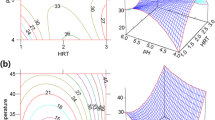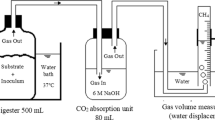Abstract
This paper reports the effects of changing pH (5–7) and temperature (T, 40–60 °C) on the efficiencies of bacterial hydrolysis of suspended organic matter (SOM) in wastewater from food waste recycling (FWR) and the changes in the bacterial community responsible for this hydrolysis. Maximum hydrolysis efficiency (i.e., 50.5% reduction of volatile suspended solids) was predicted to occur at pH 5.7 and T = 44.5 °C. Changes in short-chain volatile organic acid profiles and in acidogenic bacterial communities were investigated under these conditions. Propionic and butyric acids concentrations increased rapidly during the first 2 days of incubation. Several band sequences consistent with Clostridium spp. were detected using denaturing gel gradient electrophoresis. Clostridium thermopalmarium and Clostridium novyi seemed to contribute to butyric acid production during the first 1.5 days of acidification of FWR wastewater, and C. thermopalmarium was a major butyric acid producer afterward. C. novyi was an important propionic acid producer. These two species appear to be important contributors to hydrolysis of SOM in the wastewater. Other acidogenic anaerobes, Aeromonas sharmana, Bacillus coagulans, and Pseudomonas plecoglossicida, were also indentified.





Similar content being viewed by others
References
APHA-AWWA-WEF (2005) Standard methods for the examination of water and wastewater. American Public Health Association, Washington DC
Bagge E, Sahlstrom L, Albihn A (2008) The effect of hygienic treatment on the microbial flora of biowaste at biogas plants. Water Res 39:4879–4886
Boone DR (2001) Bergey's manual of systematic bacteriology. Springer, New York
Demirel B, Scherer P (2008) The roles of acetotrophic and hydrogenotrophic methanogens during anaerobic conversion of biomass to methane: a review. Rev Environ Sci Biotechnol 7:173–190
Dixit A, Dhaked RK, Alam SI, Singh L (2005) Characterization of Clostridium sp. RKD producing botulinum-like neurotoxin. Syst Appl Microbiol 28:405–414
Dubois M, Gilles KA, Hamilton JK, Rebers PA, Smith F (1956) Colorimetric methods for determination of sugars and related substances. Anal Chem 28:350–356
Gomec CY, Kim M, Ahn Y, Speece RE (2002) The role of pH in mesophilic anaerobic sludge solubilization. J Environ Sci Health A Tox Hazard Subst Environ Eng 37:1871–1878
Guerrero L, Omil F, Méndez R, Lema JM (1999) Anaerobic hydrolysis and acidogenesis of wastewaters from food industries with high content of organic solids and protein. Water Res 33:3281–3290
Kim M, Gomec CY, Ahn Y, Speece RE (2003) Hydrolysis and acidogenesis of particulate organic material in mesophilic and thermophilic anaerobic digestion. Environ Technol 24:1183–1190
Lee C, Kim J, Shin SG, Hwang S (2008) Monitoring bacterial and archaeal community shifts in a mesophilic anaerobic batch reactor treating a high-strength organic wastewater. FEMS Microbiol Ecol 65:544–554
Lee DH, Behera SK, Kim JW, Park HS (2009) Methane production potential of leachate generated from Korean food waste recycling facilities: a lab-scale study. Waste Manag 29:876–882
Li D, Zhou T, Chen L, Jiang W, Cheng F, Li B, Kitamura Y (2009) Using porphyritic as a new additive improving hydrolysis and acidogenesis of solid organic wastes. Bioresour Technol 100:5594–5599
Lindstrom ES, Agterveld MPKV, Zwart G (2005) Distribution of typical freschwater bacterial groups is associated with pH, temperature, and lake water retention time. Appl Environ Microbiol 71:8201–8206
Liu G, Zhang R, El-Mashad HM, Dong R (2009) Effect of feed to inoculum ratios on biogas yields of food and green wastes. Bioresour Technol 100:5103–5108
McHugh S, Carton M, Mahony T, O'Flaherty V (2006) Methanogenic population structure in a variety of anaerobic bioreactors. FEMS Microbiol Lett 219:297–304
Montgomery DC (2001) Design and analysis of experiments. Wiley, New York
Soh ALA, Ralambotiana H, Ollivier B, Prensier G, Tine E, Garcia JL (1991) Clostridium thermopalmarium sp. nov., a moderately thermophilic butyrate-producing bacterium isolated from palm wine a Senegal. Syst Appl Microbiol 14:135–139
Song M, Kim N, Lee S, HWang S (2007) Use of whey permeate for cultivating Ganoderma lucidum mycelia. J Dairy Sci 90:2141–2146
Yang K, Yu Y, Hwang S (2003) Selective optimization in thermophilic acidogenesis of cheese-whey wastewater to acetic and butyric acids: partial acidification and methanation. Water Res 37:2467–2477
Yu Y, Lee C, Kim J, Hwang S (2005) Group-specific primer and probe sets to detect methanogenic communities using quantitative real-time polymerase chain reaction. Biotechnol Bioeng 89:670–679
Yu Y, Kim J, Hwang S (2006) Use of real-time PCR for group-specific quantification of aceticlastic methanogens in anaerobic processes: population dynamics and community structures. Biotechnol Bioeng 93:424–433
Acknowledgements
This research was supported by the Korea Ministry of Knowledge and Economy (MKE) as the Manpower Development Program for Energy and Resources and the Ministry of Environment (MOE) as the Human Resource Development Project for Waste to Energy. This work was also supported by the Korea Ministry of Education, Science, and Technology (MEST) through the BK-21 program.
Author information
Authors and Affiliations
Corresponding author
Rights and permissions
About this article
Cite this article
Kim, M.D., Song, M., Jo, M. et al. Growth condition and bacterial community for maximum hydrolysis of suspended organic materials in anaerobic digestion of food waste-recycling wastewater. Appl Microbiol Biotechnol 85, 1611–1618 (2010). https://doi.org/10.1007/s00253-009-2316-x
Received:
Revised:
Accepted:
Published:
Issue Date:
DOI: https://doi.org/10.1007/s00253-009-2316-x




